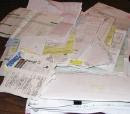
4 Steps to Getting Control of Your Receipts, Statements, and Bills
One of my top requests as a Professional Organizer is to help clients organize their personal finances. For many of us, the myriad bills, receipts, and statements that enter our homes are quickly overwhelming us. It’s hard to keep track of all that information if you don’t have a good system in place to manage it. Here are four simple steps to help you get your personal financial papers organized:
1. Gather it up. The first step to organizing your finances is to get all financial-related information in one place. If your personal financial papers are currently piled into paper bags, stuffed in shoeboxes, and dominating your desk, start by putting all the various bills, receipts, and statements in a box or pile. It’s much easier to organize when all your information is in one spot!
2. Sort and separate. Now that your papers are all together, it’s time to sort them into categories. The simplest way to organize personal finances is to separate tax-related items from ones that you won’t be claiming (ask your tax preparer for more information about your specific situation). From those two main financial types – tax/non-tax, your papers will start giving you clues to some broad categories – utilities, electronics, auto, home, etc. Create piles for each of those categories.
3. Find homes. Now it’s time to create dedicated spaces where your financial papers can live. Purchase an accordion folder and some hanging files. Into the accordion goes your tax-related info – one tab for each sub-category. The benefit of the accordion folder is that it can be easily stored for safekeeping when the tax year is over. Your non-tax-related financial information goes into the hanging files – one file for each of non-tax-related category. Continue filing receipts, statements and bills into their new homes as they come in.
4. Track it. Once you have all your financial information sorted, separated, and filed, it’s easy to take the next step and track where your hard-earned cash is going. Easy-to-use computer programs like Quicken or Money take your previously-organized financial information and let you generate budgets, reports, and projections – letting you stay in control of your financial life.
If it’s been awhile since you last organized your finances, or if it’s your first time doing so, I know the process can seem daunting – but it can be simple if you take it step-by-step. Getting your finances organized can be incredibly empowering – and the process can be easy if you follow the guidelines above.




No comments:
Post a Comment